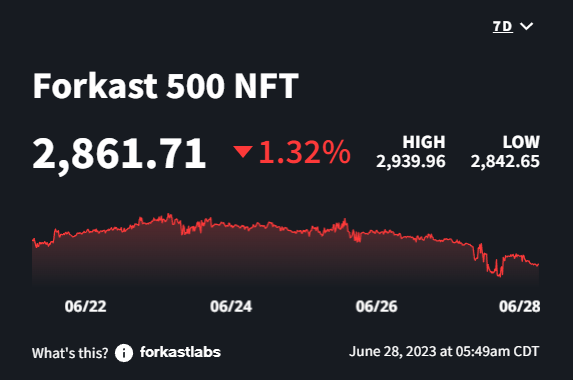In this issue
- Fidelity: Close to filing its own Bitcoin ETF
- Forkast 500 NFT Index: Azuki disappoints
- Asset tokenization in Singapore: One step closer
From the Editor’s Desk
Dear Reader,
There’s a saying in gambling circles that the house always wins. It’s not an unreasonable supposition, given the fact that if casino operators didn’t bring in more cash than they paid out, they’d be forced to shut up shop.
Some in the crypto community might be applying that same saying to the bastions of traditional finance this week as Wall Street appears to be putting another move on cryptocurrencies in which the ultimate winner seems set to be itself.
Fidelity, one of the world’s biggest asset managers, is reportedly preparing to file an application to establish a spot Bitcoin exchange-traded fund. That would be a big bet on crypto — or at least on the coin that started it all. Almost by definition, it would also be a bet against the hostility to crypto shown by the U.S. Securities and Exchange Commission since the collapse of the FTX exchange last year.
The regulator’s apparent distaste for crypto has made casualties of many companies in the sector that have bet against it in recent times. Binance, Coinbase, Kraken, Genesis and Gemini have all been on the receiving end of enforcement action, and the commission has set its sights on cryptocurrencies.
Traditional finance firms have also bet against the SEC and lost, although only in terms of commercial opportunities that have gone untapped rather than actual penalties, losses and business closures. As we note in this week’s edition of The Current Forkast, Fidelity’s application for a spot Bitcoin ETF isn’t the company’s first. Indeed, the SEC has turned down every application for such a fund to date.
But traditional finance sector players such as Fidelity and BlackRock, which lodged a spot Bitcoin ETF application a fortnight ago, are now showing increased confidence about their prospects of gaining the regulator’s favor.
Perhaps it’s because they’re buoyed by judicial skepticism about the SEC’s reasoning in denying a spot Bitcoin ETF license to crypto asset manager Grayscale. Perhaps it’s also because they sense the pendulum might have swung too far against crypto and that the regulator may be minded to offer the industry a concession in the form of a vanilla financial product.
Overall, the house needs to win to keep the tables open. Yet the original question posed by crypto was: Who runs the house? Given that the SEC appears unilaterally to have made up its mind, it feels like high time others started asking that question once again.
Until the next time,
Angie Lau,
Founder and Editor-in-Chief
Forkast.News
1. Bull run

Cryptocurrencies are receiving a significant push as Fidelity Investments is reportedly nearing the filing of its own spot Bitcoin exchange-traded fund (ETF), the Block reported Tuesday, citing people familiar with the matter.
- The move would not be Fidelity’s first attempt to file for a Bitcoin-backed ETF. In March 2021, the Wall Street giant filed for a spot Bitcoin ETF named the Wise Origin Bitcoin Trust, which was rejected by the U.S. Securities and Exchange Commission in January 2022. But it launched the Fidelity Advantage Bitcoin ETF in Canada in December 2021, which has risen 75% since the beginning of this year.
- According to the Block, Fidelity’s application will join the list of financial institutions that have recently submitted or updated their applications to issue spot Bitcoin ETFs, including BlackRock, WisdomTree, Invesco, Valkyrie and Bitwise.
- A spot Bitcoin ETF is a publicly traded investment vehicle tracking Bitcoin price, which allows investors to have Bitcoin exposure without directly handling the underlying cryptocurrency.
- “Bitcoin ETF applications have supported investors’ sentiment as institutional and retail investors could show increasing interest in the market through such investment vehicles,” said Denys Peleshok, head of Asia at Belize-based financial brokerage CPT Markets, in email comments.
- “If the SEC approves new applications, the market could record a surge in demand and in the number of buyers,” said Peleshok. “Due to the SEC’s legal stance over cryptocurrencies, the market could further concentrate on Bitcoin and Ethereum, the two largest assets in the market.”
- Since BlackRock filed for its Bitcoin ETF on June 15, Bitcoin is up by more than 22%, peaking at US$31,389 on June 23, the highest since June 2022. Bitcoin traded at US$30,433, at press time, according to data from CoinMarketCap.
Forkast.Insights | What does it mean?
The potential foray of Fidelity, globally recognized as the third largest asset manager, into the ETF domain hardly raises eyebrows among those tuned in to the vibrant buzz of Twitter’s rumor universe.
In the wake of the ETF application of the world’s largest asset manager, BlackRock, industry watchers projected that Fidelity, the Bostonian investment giant with US$4.2 trillion in assets under management, would be the subsequent contender to lodge and apply for a spot Bitcoin ETF. This topic also fuelled speculation that Fidelity might put in a bid for Grayscale, the digital asset manager responsible for the US$13.5 billion Grayscale Bitcoin Trust, the world’s biggest Bitcoin fund. So far, there has been no substantial evidence for the buyout.
Fidelity has taken a proactive stance in embracing Bitcoin and other digital assets, eclipsing many of its traditional finance contemporaries. The firm claims that its research on the asset class dates back to 2014.
In 2018, the firm launched an institutional trading platform for Bitcoin and Ethereum. A year later, in 2019, it expanded its venture into the Bitcoin mining business through Bitcoin technology firm Blockstream’s institutional mining service. Last year, it even joined the lengthy list of firms whose Bitcoin ETF applications got rejected by the SEC. And last week, EDX Markets, a non-custodial crypto exchange backed by Fidelity and other Wall Street titans, went live.
In addition, Fidelity has shown an assertive drive in obtaining indirect exposure to Bitcoin via Microstrategy, the preeminent corporate Bitcoin holder globally. Fidelity has secured its position as Microstrategy’s third largest shareholder, possessing 6.7% of the stock, valued at over US$225 million. BlackRock follows as the fourth largest owner with 5.58%, approximating around US$185 million.
Despite the entrance of these behemoth asset managers into the U.S. ETF race, the waiting list is long. ARK Invest Chief Executive Officer Cathy Wood claims that her firm is in position to launch the first spot-Bitcoin ETF in the world’s largest economy.
2. Liquid dreams

The NFT markets saw another week of decline, and again, Ethereum’s NFT ecosystem is dragging the broader market down. The Forkast 500 NFT Index is down 1.32%, as Ethereum’s decline of 1.51% stands in stark contrast to Solana, Polygon, and Cardano’s gains in value of 1.7%, 1.23% and 5.75%, respectively.
- Ethereum sales volume rose 318% on Thursday following Azuki’s Elementals mint, which brought in US$38 million to the Azuki team in just 15 minutes.
- Azuki’s floor price decreased 45% to 9 Ether following the Elementals mint, and the average sales price declined to US$23,000, down from US$39,000 the previous seven days.
- Bored Ape Yacht Club’s average sales price is up in the past seven days to US$79,214. However large BAYC holders like Machi Big Brother and Franklin have combined to sell over 60 Bored Apes, applying downward pressure on the collection.
- Solana’s 98,917 transactions on June 25 were its single highest daily total of NFT transactions in over eight months. September 2022 was the last time the blockchain had this level of activity, when the Y00ts were still surging on Solana.
- Seven-day sales volume was up across several blockchains with Ethereum up 105%, Bitcoin 22%, Solana 24%, and Polygon 10%. Mythos Chain, BNB, and Flow were down 18%, 20% and 23%, respectively.
- DeGods is now the third most expensive PFP based on floor price following Azuki’s falling prices. Azuki’s cheapest NFTs are selling for as low as 8.5 ETH, while DeGods is nearly 1 ETH higher at 9.5 ETH.
Forkast.Insights | What does it mean?
This year’s biggest new NFT mint took place on Tuesday, as one of the top NFT projects, Azuki, delivered a new collection called Elementals. While some were hopeful the new collection would breathe life into the NFT markets, it instead drained liquidity from traders who sold assets across projects to afford the hefty 2 ETH mint price. The impact was visible on the Forkast 500 NFT Index even in the midst of Ethereum NFTs having its single highest day of sales volume this year with US$58 million.
Azuki’s Elementals did provide some lucky traders with rare Elementals NFTs that were flipped for over 30 ETH, but most secondary sales are taking place well below the collection’s 2 ETH mint price. Instead of Azuki’s Elementals helping the broader NFT ecosystem, it instead sucked liquidity from holders, and almost across the board, brought other collections’ sales prices down with it.
What went wrong with Azuki’s mint is a familiar story, and shows that the NFT space may not be as mature as some would like to believe. Starting from the initial sale that left many Azuki and Beanz holders stuck on a loading page, and ultimately unable to mint, to the massively underwhelming art reveal that almost looks like duplicates of the main Azuki collection, NFT projects talk about innovation, yet time after time, fail to deliver it.
For all the talk of innovation, we have witnessed few examples of it, and other than functioning as ‘meme coins’, traders shouldn’t expect another NFT boom until we see actual innovation.
If the Azuki team can turn around the current negative sentiment in their project and help foster the higher floor prices that their holders have come to expect, we may then see sales with profits that roll into existing collections floors. We’ll be watching.
3. Singapore calling

The Monetary Authority of Singapore (MAS), the city state’s central bank, has proposed a framework to design open and interoperable networks for digital assets, as the country seeks to harness the power of asset tokenization to improve its traditional financial services.
- “The real value in the digital asset ecosystem” lies in the tokenization of real-world and financial assets through distributed ledger technologies and smart contracts, which could “enhance the efficiency, accessibility, and affordability of financial services,” MAS wrote in its report.
- “Unless digital asset networks are interoperable, both with each other and with traditional financial market infrastructures, fragmentation would reduce the network benefits and can create frictions such as inaccessibility, increased liquidity requirements due to separation of liquidity pools, and pricing arbitrage,” noted MAS.
- MAS’ proposal – jointly developed with the Bank for International Settlements and other financial institutions – is part of Singapore’s Project Guardian initiatives announced in May 2022 to explore the adoption of asset tokenization and decentralized finance in the city state’s financial industry.
- MAS also announced an expansion of Project Guardian to test the potential of asset tokenization across more financial asset classes, enlisting 11 financial institutions — including banking giants Citi, HSBC, DBS and Standard Chartered — to form the Project Guardian Industry Group to lead industry pilots in asset and wealth management, foreign exchange and fixed income.
- Japan Financial Services Agency, the first overseas financial regulator to join Project Guardian, will work with MAS on digital asset innovation while safeguarding against risks to financial stability and integrity.
- MAS’ move comes as Singapore seeks to utilize the power of blockchains in its financial system, while minimizing risks of crypto assets. Last Thursday, The Asia-Pacific branch of technology firm Ripple Labs said it would start offering crypto-enabled digital payment services in Singapore after receiving in-principle approval from the MAS.
- Also on Thursday, MAS released a whitepaper – jointly developed by the International Monetary Fund, Amazon, DBS Bank, and multiple other industry players.– for “purpose-bound” money, detailing a technical overview of digital currencies designed for specific purposes.
Forkast.Insights | What does it mean?
The Monetary Authority of Singapore’s announcement of a framework for interoperable digital asset networks stands out as an example of Singapore doing what it does best: high-tech, innovative efficiency — shepherded, of course, by the state.
The fact that the country’s de facto central bank is developing its framework jointly with the Bank for International Settlements and the International Organization of Securities Commissions simply emphasizes the establishment credentials of the initiative.
Coming less than a month after Hong Kong unveiled its virtual asset licensing framework — a cornerstone of city authorities’ plan to welcome crypto back after imposing tough restrictions on it — Singapore’s framework may have the feel of a riposte to Hong Kong’s recent punt on digital assets, even though it has long been in the works. But to view it in such a way would be mistaken.
On the contrary, Hong Kong’s rollout of digital asset licensing rules might be interpreted by cynics as a roll of the dice by the rulers of a city suffering hard times. After all, Hong Kong’s star has waned in recent years following the authorities’ crushing of its once-celebrated first-world freedoms and their handling of the Covid pandemic, both of which have prompted an exodus of talent and a collapse of foreign business confidence.
Hong Kong’s attitude to crypto has see-sawed over the years, as has Singapore’s, to a lesser extent. But overall, the Southeast Asian nation has been honing its approach to digital assets fairly steadily and for a long time, and its latest plan to develop the industry marks merely one more milestone along that road.
The MAS’s initiative has less of an air of opportunism about it than Hong Kong’s recent embrace of digital assets. In fact, the authority’s plan is so measured, technocratic, centralizing and heavy on the involvement of TradFi heavyweights that it feels more like fintech than frontier finance of the sort imagined by crypto and digital asset purists.
As a development spawned by the disruptive phenomenon of digital assets, Project Guardian, as the initiative is named — and as its name suggests — appears to represent the very opposite of disruption. It will likely be seamless, safe and secure — and not a little dull. Right on brand for Singapore. What’s more interesting, however, is whether it will join previous initiatives implemented by the city-state as another of its successful exports.




